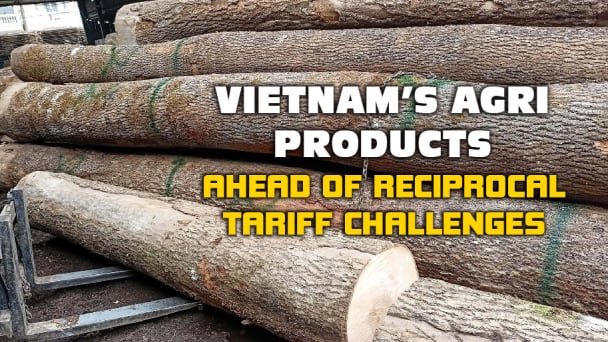June 5, 2025 | 14:59 GMT +7
June 5, 2025 | 14:59 GMT +7
Hotline: 0913.378.918
June 5, 2025 | 14:59 GMT +7
Hotline: 0913.378.918

Vietnamese tuna faces major challenges in the U.S. market. Photo: Son Trang.
Currently, the United States is the main market for tuna in Vietnam. Tuna exports to the United States totaled USD 388 million in 2024, which accounted for 38% of Vietnam's total tuna export revenue.
Tuna exports to the United States experienced an increase in the initial four months of the current year. The value increased by 11% year over year, reaching USD 124 million.
Nevertheless, Vietnamese exporters are experiencing an increase in their level of anxiety. In addition to reciprocal tariffs, the industry has received discouraging news from the National Oceanic and Atmospheric Administration (NOAA) under the U.S. Department of Commerce.
NOAA recently issued a preliminary judgment that asserts Vietnam's marine mammal conservation and management measures are not comparable to those of the United States for 12 fishing methods. Vietnamese seafood, including tuna, will be prohibited from accessing the U.S. market on January 1, 2026, if Vietnam fails to comply with NOAA's requirements within the designated timeframe.
This ruling, along with tariff uncertainties, is already having an effect on Vietnam's tuna commerce with the United States. Although exports to this market increased by 15% year-over-year in Q1, the growth rate had slowed to 11% by the end of April.
The tuna sector is actively shifting toward new markets in response to these headwinds. The United Kingdom, Russia, and the Middle East are among the many prospective destinations for increased tuna exports.

Fishermen unload tuna onshore. Photo: Son Trang.
In 2024, the Middle East was Vietnam's fourth-largest tuna market, following the U.S., EU, and CPTPP countries, with an export value of nearly USD 113 million. Israel, Lebanon, and Egypt are the primary markets for Vietnamese tuna, which is already widely available in most Middle Eastern countries. Israel is the most notable among them, with tuna exports increasing by 30% in 2024 compared to 2023, accounting for nearly 7% of the total tuna export value.
In addition to Israel, the United Arab Emirates is considered a high-potential market. Ms. Nguyen Thi Van Ha, a tuna market expert from the Vietnam Association of Seafood Exporters and Producers (VASEP), has stated that the Comprehensive Economic Partnership Agreement (CEPA) between Vietnam and the UAE has created new export opportunities. CEPA will result in a reduction of import tariffs on Vietnamese tuna products to the UAE to 0% upon its implementation.
Additionally, Russia has shown a heightened interest in Vietnamese tuna. Vietnamese tuna exports to Russia reached roughly USD 45 million in 2024, the highest level in a decade and five times the level in 2020. Exports increased by 15% from the same period in 2024, exceeding USD 10 million in Q1 of this year.
Russia is one of the top 30 tuna importers globally, and its demand has been steadily increasing. Vietnam and Russia are in the process of laying the groundwork for further market expansion through bilateral initiatives aimed at reducing trade barriers.
Also promising is the United Kingdom, particularly in light of its participation in the Comprehensive and Progressive Agreement for Trans-Pacific Partnership (CPTPP). Vietnam's tuna exports to the United Kingdom have been consistently increasing since 2021, despite modest current export volumes.
The UK-Vietnam Free Trade Agreement (UKVFTA) was the governing framework for Vietnamese tuna exports to the UK market prior to the UK's participation in the Comprehensive and Progressive Agreement for Trans-Pacific Partnership (CPTPP). In this agreement, only 11,500 tonnes of Vietnamese tuna products were eligible for a 0% preferential tariff.
Nevertheless, Vietnam's processed and canned tuna exports to member countries are benefiting from a progressive reduction in tariffs from 20% to 0% over a seven-year period as a result of the CPTPP. By December 2024, the United Kingdom's accession to the Comprehensive and Progressive Agreement for Trans-Pacific Partnership (CPTPP) is expected to further enhance the market access of Vietnamese tuna in the years ahead.
Vietnamese tuna is not the only product facing headwinds in the U.S. market. Other key agricultural and wood-based exports are also grappling with reciprocal tariffs tied to trade disputes and environmental standards.
For instance, wood manufacturers are urgently seeking legal clarity and new certifications to maintain access to the U.S., while rice exporters are taking advantage of temporary supply gaps. The government and business associations are calling for more targeted trade diplomacy and deeper cooperation under existing FTAs to address this broader challenge.
Translated by Linh Linh

(VAN) Although the U.S. holds a small share of Vietnam’s rubber exports, newly imposed reciprocal tariffs are expected to impact the sector. Vietnamese enterprises must optimize the use of significant markets and free trade agreements.

(VAN) Vietnam's pepper industry is looking forward to the final tariff decision in order to sustain its robust presence in the United States, the country's biggest pepper market.

(VAN) The U.S. is the largest market for Vietnamese cashew nuts. However, when exports to the U.S. encounter difficulties due to reciprocal tariffs, Vietnamese cashews still have many other potential markets.

(VAN) Reciprocal tariffs present a significant obstacle to Vietnam's wood exports to the United States; however, domestic wood businesses are endeavoring to preserve their market share in this critical market.

(VAN) Businesses in Vietnam are attempting to export rice to the United States ahead of the implementation of reciprocal tariffs, while remaining their optimism regarding this critical market.

(VAN) From containers of cashew nuts, shrimp to in-depth technical dialogues, agricultural cooperation between Vietnam and the United States is entering a period of sustainable and two-way development.